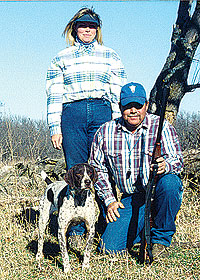By James B. Spencer
 This tip is from Keith Gulledge of Blue Dawn Kennels, 3179 CC 50 Road, Madison, KS 66860; (620) 437-2929; Web site www.bluedawnken.com; e-mail robbi_gulledge@hotmail.com. |
"We spend about seven months every year traveling," Keith said, "with 25 to 30 shorthairs. We keep each one in his own crate, one that is well-ventilated and large enough for the dog's comfort. Individual crating keeps them from fighting and causing problems for the driver."
Keith said he might crate puppies in pairs, especially if they might otherwise suffer from separation anxiety. In a pinch he would crate a grown male and a grown female together, but he prefers to crate each dog individually.
He said that while on the road, he stops to exercise and "air" his dogs about every six hours.
"If your dog is crated inside your vehicle," he added, "he'll let you know if he needs to get out more often."
Keith recommends taking along enough food from home for the entire trip, plus a little extra for unexpected delays on the road. He said that you should take some water along, too, but if you mix it with the available water wherever you are, your dog will stay healthy, although his stool might be a little soft sometimes.
"Don't forget to take whatever equipment you'll need," he said, "like your leash, whistle, blank pistol and shells, flash collar, tracking collar, bark collar, water jug, roading harness, check cord and whatever else you normally use for training and handling. In your rush to get started, it's so easy to forget to pack some of these things."
Keith takes along some pretty advanced first aid equipment, like syringes, needles, various medications, bandages, staple gun and remover, peroxide, alcohol, betadine scrub and a thermometer. However, most dog owners lack the knowledge to use many of these items effectively, so rely on a veterinarian's recommendations for first aid equipment.
"It's wise to know where you can get emergency veterinary care near your destination," he added. "Along the way, every town will have a veterinarian you can easily locate."
Keith recommends that when you stop at a restaurant, make sure your dogs are properly ventilated. Then you should park your vehicle where you can watch it while you are eating.
When staying in a motel that allows pets in the room, Keith recommends that you crate your dog in your room rather than let him run loose. To keep him quiet when you are out of the room, use a bark collar. When staying in a motel that doesn't allow pets in the rooms, he said you should lock your dog in your vehicle and make sure he has plenty of ventilation. In cold weather, he also needs good bedding.
"In warm weather," he said, "make sure your dog doesn't overheat, both while traveling and while hunting or trialing. Overheating is a serious problem in that an overheated dog can die very quickly."
He said the early signs of overheating are slowing down, getting wobbly and panting severely. You can prevent overheating by keeping your dog well-ventilated with plenty of drinking water. If your dog does overheat, you should pour a small amount of alcohol on the inside of his upper thighs to cool him down.
"But," Keith added, "don't overdo this, because too much alcohol can send him into hypothermia."
Keith added this as a closing thought: "Be attentive to your dog, to the temperature outside, and to conditions wherever you let him out. In short, treat him as well as you treat yourself."






